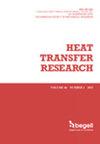Numerical Investigations of Thermo-Fluidic Characteristics in Innovative Parallel Plate Fin Heat Sink Design Subjected to Parallel Flow: Exploring the Staggering Effect
IF 1.6
4区 工程技术
Q3 THERMODYNAMICS
引用次数: 0
Abstract
The persistent advancement of miniaturized electronic devices and their increased performance exacerbates the challenges concerning efficient heat transfer. This study explores innovative configurations of parallel plate fin heat sink for MOSFET cooling, combining experimental validation and numerical simulations using the ANSYS Fluent solver. A heat sink, denoted as HS1, featuring seven parallel plate fins of length L, serves as the subject of both experimental and numerical analysis. Five alternative configurations designated HS2 to HS6, maintain the overall length of HS1 whilst examining different segmentations of the middle fins. HS2, HS3, and HS4 are segmented with lengths L/3, L/4, and L/7 respectively. Introducing staggered fins, HS5 and HS6, segmented with L/7, generates translations of L/14 and L/28, respectively. Staggered fins are positioned across all proposed heat sinks at S/2 (S is the fins spacing). Analysis of combined mass flowrate and power losses on HS1 reveals distinct trends in thermal resistance and maximum junction temperatures with varying mass flowrates. The heat sink configurations exhibit a significant reduction in thermal resistance compared to HS1. The exploration of the thermo-fluidic characteristics of each configuration unveils the intricate fluid dynamics and heat transfer phenomena occurring within the heat sinks. These configurations aim to minimize the thermal resistance between the MOSFETs' junction and the ambient, effectively reducing operational temperatures. Results also demonstrate significant improvements in heat dissipation efficiency, with the best configuration showcasing a reduction in thermal resistance up to 25.37%.受平行流影响的创新型平行板翅式散热器设计的热流体特性数值研究:探索交错效应
微型电子设备的不断进步及其性能的提高,加剧了高效传热方面的挑战。本研究结合实验验证和使用 ANSYS Fluent 求解器进行的数值模拟,探索了用于 MOSFET 冷却的平行板翅片散热器的创新配置。实验和数值分析的对象是一个名为 HS1 的散热器,它具有七个长度为 L 的平行板翅片。从 HS2 到 HS6 的五个备选配置保持了 HS1 的总长度,同时对中间鳍片的不同分段进行了研究。HS2、HS3 和 HS4 的分段长度分别为 L/3、L/4 和 L/7。引入交错的鳍,HS5 和 HS6,以 L/7 分段,分别产生 L/14 和 L/28 的平移。交错鳍片在所有建议的散热器上的位置均为 S/2(S 为鳍片间距)。对 HS1 的综合质量流量和功率损耗进行分析后发现,随着质量流量的变化,热阻和最大结温呈现出明显的变化趋势。与 HS1 相比,散热器配置的热阻显著降低。对每种配置的热流体特性的研究揭示了散热器内部错综复杂的流体动力学和热传导现象。这些配置旨在最大限度地降低 MOSFET 结与环境之间的热阻,从而有效降低工作温度。结果还表明,散热效率有了显著提高,最佳配置的热阻降低率高达 25.37%。
本文章由计算机程序翻译,如有差异,请以英文原文为准。
求助全文
约1分钟内获得全文
求助全文
来源期刊

Heat Transfer Research
工程技术-热力学
CiteScore
3.10
自引率
23.50%
发文量
102
审稿时长
13.2 months
期刊介绍:
Heat Transfer Research (ISSN1064-2285) presents archived theoretical, applied, and experimental papers selected globally. Selected papers from technical conference proceedings and academic laboratory reports are also published. Papers are selected and reviewed by a group of expert associate editors, guided by a distinguished advisory board, and represent the best of current work in the field. Heat Transfer Research is published under an exclusive license to Begell House, Inc., in full compliance with the International Copyright Convention. Subjects covered in Heat Transfer Research encompass the entire field of heat transfer and relevant areas of fluid dynamics, including conduction, convection and radiation, phase change phenomena including boiling and solidification, heat exchanger design and testing, heat transfer in nuclear reactors, mass transfer, geothermal heat recovery, multi-scale heat transfer, heat and mass transfer in alternative energy systems, and thermophysical properties of materials.
 求助内容:
求助内容: 应助结果提醒方式:
应助结果提醒方式:


